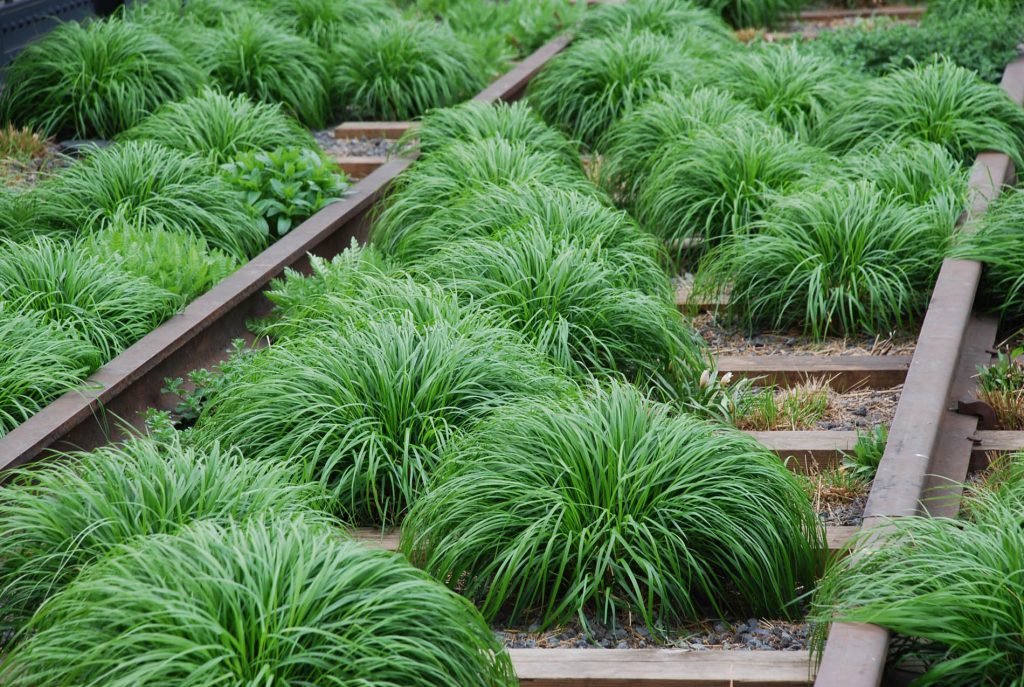Native species help restore habitats and support the life that relies on them
The pawpaws growing in Avi Askey’s yard help to feed the family in the house. And the Zebra Swallowtail butterfly, Tennessee’s state butterfly, relies on it for food and a place to live.
Carex sedges are beautiful grass-like evergreens, but they also help prevent soil erosion and provide nectar for insects early in the spring.
Native plants like these are growing in popularity as gardeners get savvier about their impact on the environment and the birds, pollinators, and other insects that inhabit it.
Barbra Bunting, a longtime Knox County Master Gardener, wanted to convert 7,000 square feet of what used to be lawn to native plants. She worked with native plant designers Leah Gardner and Joan Monaco of Gardner Monaco Design, who recommended plants that would do well in the space. She added her own research to theirs and put together a list of plants based on the soil and the orientation of the sun. Then she started growing them from seed.
“I probably planted several thousand plants, and I have several more thousand to go in this year,” she says. “I want to simulate how things would naturally grow without our intervention, how they would grow in a field or the woods. Sometimes there are dozens of plants in a square foot of space.”

Bunting, who lives on six acres of land in Hardin Valley, doesn’t recommend that gardeners new to native plants tackle such an undertaking. “Start small. Not 7,000 square feet.”
Bunting and the folks at Tennessee Naturescapes, a native plant nursery in Clinton, call native gardening the wave of the future. “It’s here to stay,” says Becky Marlow, a nursery worker for 25 years. “The whole mission of it—the impact on our planet—is something more people are willing and eager to do something about.” While a single person can’t solve all our environmental challenges, they can contribute to the cause just outside their own front door by planting natives.
Devoted to the cause
Askey has been selling native plants from his nursery, Overhill Gardens, in Vonore for 24 years, and he uses them to design native landscapes around East Tennessee, including at Seven Islands State Birding Park in East Knox County and Suttree Landing Park in South Knoxville. “My first draw was aesthetic—I valued the sense of place the native plants provide from a visual point of view. Add to that the relationships between plants and insects and birds that have evolved over the millennia … supporting that in suburban environments has become really important.”
Askey acknowledges that natives may lack the vivid colors and huge blooms one sees at bigbox garden centers. “There’s a shift; I certainly experienced it. The more I became familiar with natives the less appealing the gaudiness of some flowers became.” Not that natives lack color: he cites the showy blooms of Indian pinks and native azaleas as examples and adds that the fruits that may follow or the textural interest of foliage increases their engagement. “It takes a little more design skill to arrange a seasonal progression of interest throughout the year.”

Tennessee Naturescapes in Clinton has been selling native plants since founder Lori McAlister, now retired, started it out of her home in 2007. It’s grown over the years and now offers about 300 different species of plants native to the Southeast, including perennials, wildflowers, shrubs and trees. “Our philosophy is we’re trying to restore the ecosystem we’ve altered through human activities and provide food and shelter for wildlife,” says horticulturist Rich Curzon. “And restore plant diversity. Too many invasive plants—English ivy, Chinese privet, Japanese honeysuckle—have been changing our habitats and choking out natives.”
Becky Marlow adds that natives also tend to be easier to grow. “They’re already adapted to the climate and the soil here, and once they’re established in the ground—which takes about a year—you don’t have to worry about them. A lot of non-natives didn’t survive the cold snap we had at Christmas. The natives did well.”
How to get started
Marlow and Curzon echo Bunting’s advice to turn your garden over to native plants a step at a time. Start a small native shade garden under a tree. Maybe shrink the size of your lawn a bit. Remove plants that are known to be invasive. Or if you can’t yank them out, then manage them. “Don’t let the privet begin to berry so birds won’t scatter the seeds everywhere,” Marlow said.
And learn what you’re doing. There are lots of resources for doing so.
The Tennessee Native Plant Society hosts free monthly native plant seminars on Zoom. Field trips designed to promote interest in Tennessee’s native plants are open to non-members as well as members.
Wild Ones recently moved its Smoky Mountains Chapter from Sevier County to Knoxville. The nonprofit promotes environmentally sound landscaping practices to preserve biodiversity through the preservation, restoration and establishment of native plant communities. It offers workshops and webinars on native plants that can add up to a certificate in Gardening with Natives.
Homegrown National Park works nationally with the same mission. Videos by cofounder Doug Tallamy answer a lot of the questions gardeners have about transitioning to native plants.
Pollinator Partnership also a national organization, offers a wide range of educational resources for just about every region of the United States. The organization is dedicated to the health of pollinators which are critical to food and ecosystems, through conservation, education, and research.
And don’t forget about Native Plant Rescue Squad, working hard to rescue plants in need of saving. Check out Cityview’s most recent story on the squad here: cityviewmag.com/native-plant-rescue.
